Instructions for Side by Side Printing
- Print the notecards
- Fold each page in half along the solid vertical line
- Cut out the notecards by cutting along each horizontal dotted line
- Optional: Glue, tape or staple the ends of each notecard together
exam 5
front 1 A simple nervous system A) must include chemical senses, mechanoreception, and vision.
| back 1 E) includes sensory information, an integrating center, and effectors. |
front 2 Which of the following is (are) characteristic of a simple nervous system? a. a nerve net such as is found in cnidarians | back 2 d. both A and C * a nerve net such as is found in cnidarians * c. having electrical impulses traveling in both directions |
front 3 The heart rate decreases in response to the arrival of A) acetylcholine. | back 3 A) acetylcholine. |
front 4 Increases and decreases of the heart rate result from changes in the activity of the A) corpus callosum. | back 4 B) medulla oblongata. |
front 5 An amino acid neurotransmitter that operates at inhibitory synapses in the brain is A) acetylcholine. | back 5 E) gamma-aminobutyric acid, GABA. |
front 6 In the human knee-jerk reflex, as the calf is raised from the vertical toward the horizontal, the muscles of the quadriceps (flexors on the ventral side of the thighs) and the muscles of the hamstring (extensors on the dorsal side of the thighs) are A) both excited and contracting. | back 6 C) excited and inhibited, respectively. |
front 7 The stretch receptors of the sensory neurons in the human knee-jerk reflex are located in the A) gastrocnemius muscle, in the calf. | back 7 C) quadriceps, the flexor muscles on the ventral side of the thighs. |
front 8 Cranial nerves originate in the brain and are thus part of the A) central nervous system. | back 8 A) central nervous system. |
front 9 Which of the following shows a brain structure correctly paired with one of its primary functions? A) frontal lobedecision making | back 9 A) frontal lobedecision making |
front 10 If you were writing an essay, the part of your brain that would be actively involved in this task is the A) temporal and frontal lobes. | back 10 A) temporal and frontal lobes. |
front 11 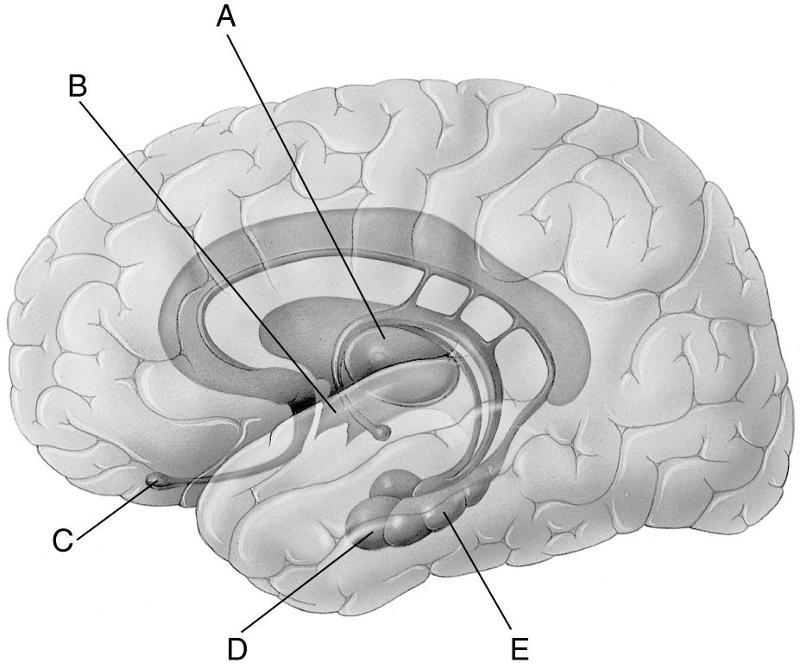 In the figure, which letter points to the amygdala? A) A | back 11 D) D |
front 12 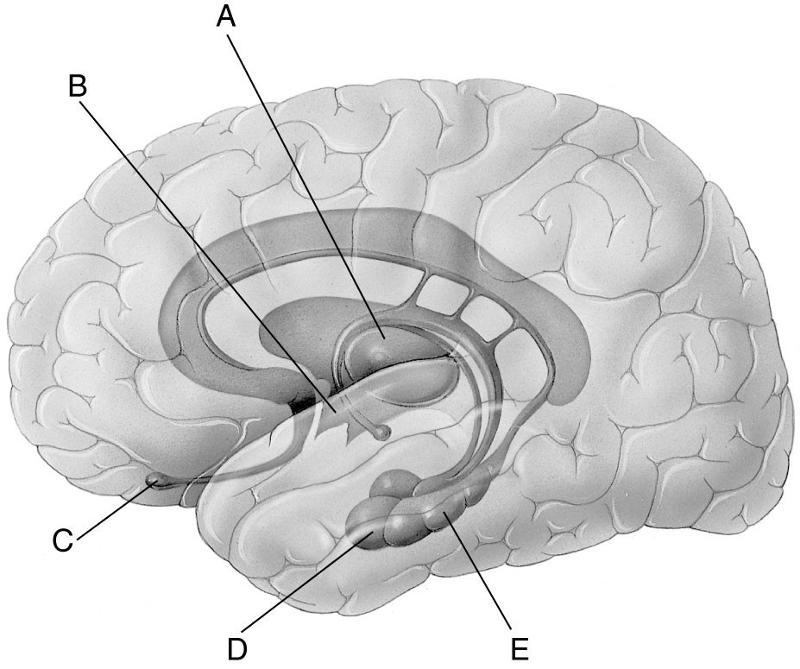 54) In the figure, which letter points to the thalamus? A) A | back 12 A) A |
front 13 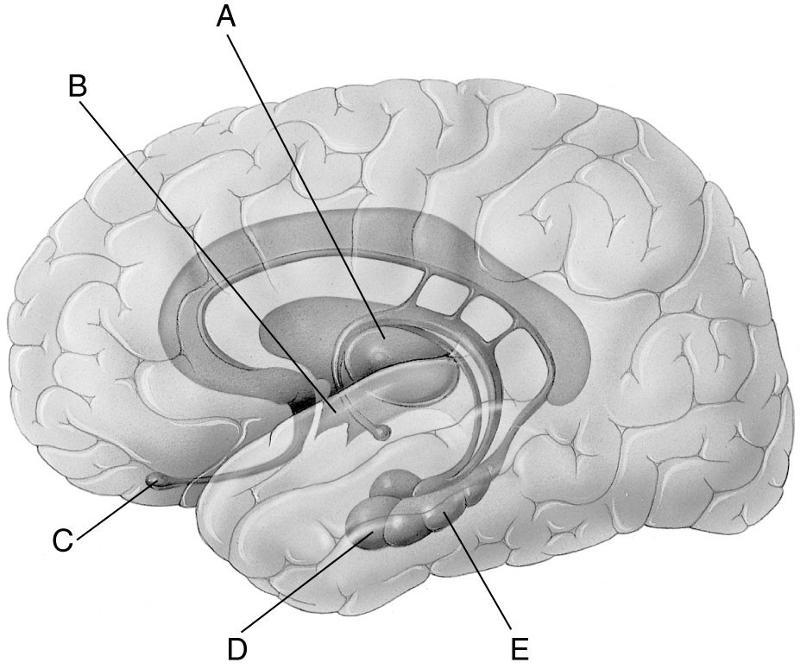 55) In the figure, which letter points to the olfactory bulb &
hippocampus? | back 13 C) C & D |
front 14 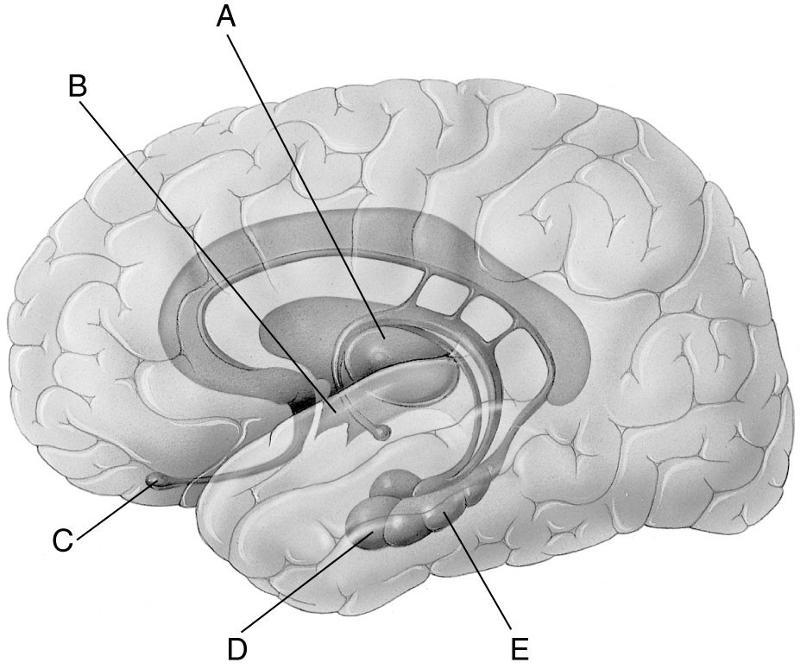 In the figure, which letter points to the hypothalamus? A) A | back 14 D) D |
front 15 The regulation of body temperature derives from the activity of the A) cerebrum. | back 15 D) hypothalamus. |
front 16 Bipolar disorder is similar to schizophrenia in that researchers suspect that both include trouble with the neurotransmitter A) dopamine. | back 16 A) dopamine |
front 17 Bipolar disorder differs from schizophrenia in that A) schizophrenia results in hallucinations. | back 17 A) schizophrenia results in hallucinations. |
front 18 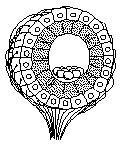 The structure diagrammed in the figure is the A) neuromast. | back 18 B) statocyst. |
front 19 Sensory transduction of light/dark information in the vertebrate retina is accomplished by A) ganglion cells. | back 19 E) rods and cones. |
front 20 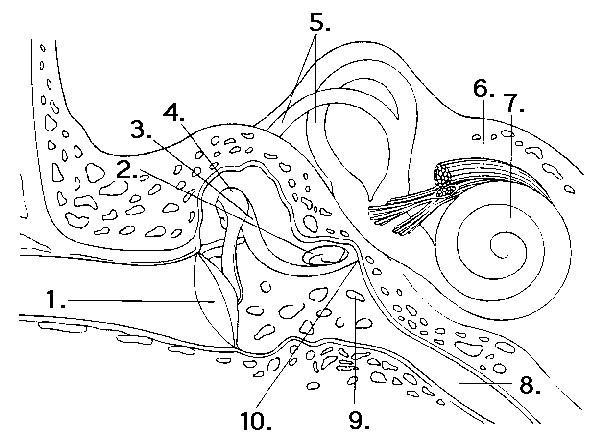 The structure involved in equalizing the pressure between the ear and the atmosphere is represented by number A) 7. | back 20 C) 8. |
front 21 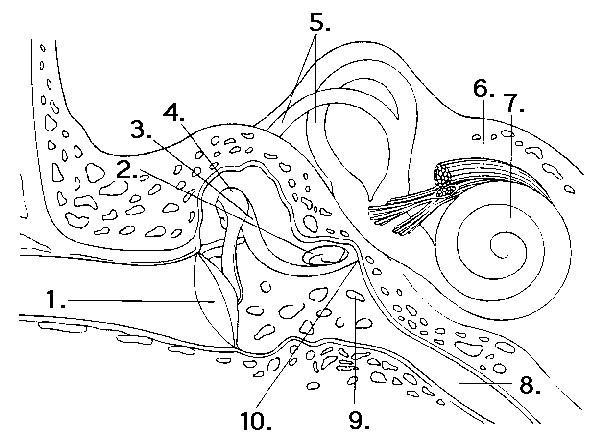 The sense of head motion begins with sensory transduction by the structures at which numbers? A) 2, 3, and 4. | back 21 D) 5 |
front 22 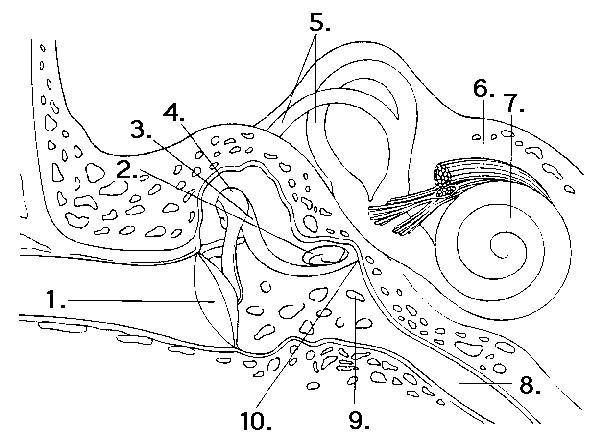 ) Vibrations of the tympanic membrane to the oval window are
transmitted by the structures at which numbers? | back 22 C) 3 and 4. |
front 23 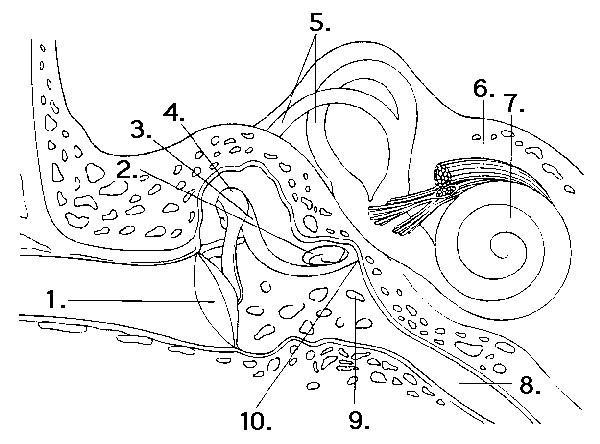 The organ of Corti is represented by which number? | back 23 E) 7. |
front 24 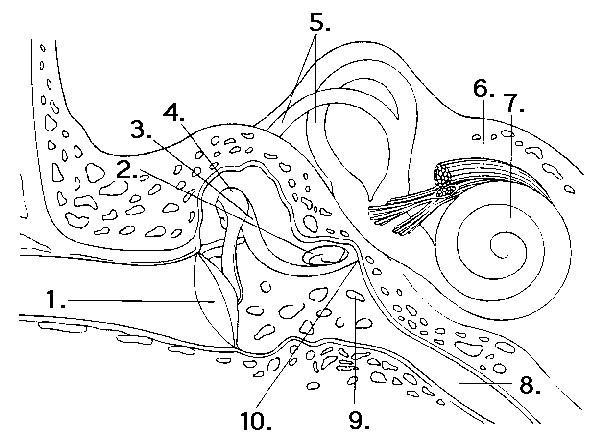 Hair cells are found in structures represented by numbers A) 1 and 2. | back 24 C) 5 and 7. |
front 25 Statocysts contain cells that are A) mechanoreceptors which function in orientation to gravity.
| back 25 A) mechanoreceptors which function in orientation to gravity. |
front 26 Muscle cells are stimulated by neurotransmitters released from the synaptic terminals of A) T tubules. | back 26 B) motor neuron axons. |
front 27 The hydrostatic skeleton of the earthworm allows it to move around in its environment by A) walking on its limbs. | back 27 D) using peristaltic contractions of its circular and longitudinal muscles. |
front 28 Which of the following areas of study focuses on the exchange of energy, organisms, and materials between ecosystems? A) population ecology | back 28 C) landscape ecology |
front 29 Ecology is | back 29 the scientific study of organisms interactions between themselves and the environment |
front 30 Which of the following levels of ecological organization is arranged in the correct sequence from most to least inclusive? A) community, ecosystem, individual, population | back 30 B) ecosystem, community, population, individual |
front 31 The oceans affect the biosphere in all of the following ways except A) producing a substantial amount of the biosphere's oxygen.
| back 31 D) regulating the pH of freshwater biomes and terrestrial groundwater. |
front 32 Which series is correctly layered from top to bottom in a tropical rain forest? A) ground layer, shrub/immature layer, under story, canopy,
emergent layer | back 32 D) emergent layer, canopy, under story, shrub/immature layer, ground layer |
front 33 In the development of terrestrial biomes, which factor is most dependent on all the others? A) the species of colonizing animals | back 33 A) the species of colonizing animals |
front 34 Which of the following biomes is correctly paired with the description of its climate? A) savanna–low temperature, precipitation uniform during the
year | back 34 E) tropical forests–nearly constant day length and temperature |
front 35 Suppose that the number of bird species is determined mainly by the number of vertical strata found in the environment. If so, in which of the following biomes would you find the greatest number of bird species? A) tropical rain forest | back 35 A) tropical rain forest |
front 36 Which of the following is characteristic of most terrestrial biomes? A) annual average rainfall in excess of 250 cm | back 36 D) vegetation demonstrating vertical layering |
front 37 Which of the following are important biotic factors that can affect the structure and organization of biological communities? A) precipitation, wind | back 37 C) predation, competition |
front 38 Coral reefs can be found on the southern east coast of the United States but not at similar latitudes on the southern west coast. Differences in which of the following most likely account for this? A) sunlight intensity | back 38 D) ocean currents |
front 39 Injury localized to the hypothalamus would most likely disrupt A) short-term memory. | back 39 E) regulation of body temperature. |
front 40 A cow's herbivorous diet indicates that it is a(n) A) primary consumer. | back 40 A) primary consumer. |
front 41 Which of the following ecosystems would likely have a larger net primary productivity/hectare and why? A) open ocean because of the total biomass of photosynthetic
autotrophs | back 41 B) grassland because of the small standing crop biomass that results from consumption by herbivores and rapid decomposition |
front 42 Which of the following might be an investigation of microclimate?
| back 42 D) the effect of sunlight intensity on species composition in a decaying rat carcass |
front 43 Which of the following is an ecosystem? | back 43 D)all of the organisms living in your aquarium and the abiotic factors with which they interact |
front 44 How do iron levels affect phytoplankton populations in a marine ecosystem? A)Without iron, eukaryotic phytoplankton populations fall
because they cannot convert atmospheric N2 to nitrogenous minerals.
| back 44 C)Iron stimulates the growth of cyanobacteria, which convert atmospheric N2 to nitrogenous minerals, stimulating the growth of phytoplankton. |
front 45 Which of the following can be said about light in aquatic environments? A) Water selectively reflects and absorbs certain wavelengths
of light. | back 45 A) Water selectively reflects and absorbs certain wavelengths of light. |
front 46 In which of the following terrestrial biome pairs are both parts dependent upon periodic burning? A) tundra and coniferous forest | back 46 B) chaparral and savanna |
front 47 A population of ground squirrels has an annual per capita birth rate of 0.06 and an annual per capita death rate of 0.02. Calculate an estimate of the number of individuals added to (or lost from) a population of 1,000 individuals in one year. A) 120 individuals added | back 47 B) 40 individuals added During exponential growth, a population always |
front 48 During exponential growth, a population always A) grows by thousands of individuals. | back 48 B) grows at its maximum per capita rate. |
front 49 Why do some invertebrates, such as lobsters, show a "stair-step" survivorship curve? A) Many invertebrates mate and produce offspring on multiyear
cycles. | back 49 C) Many invertebrates molt in order to grow, and they are vulnerable to predation during their "soft shell" stage. |
front 50 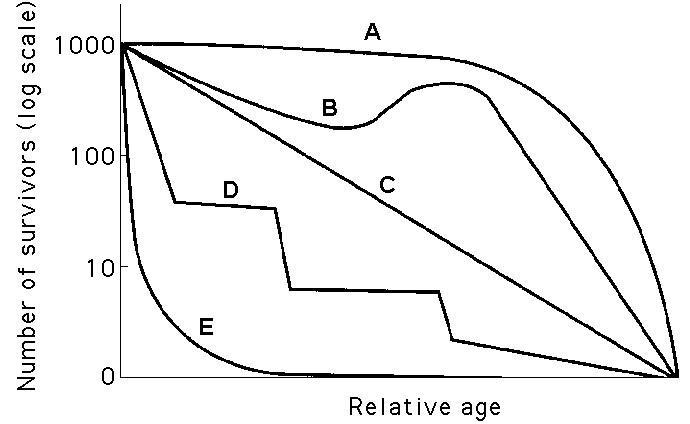 Which curve best describes survivorship in marine molluscs? A) A | back 50 E) E |
front 51 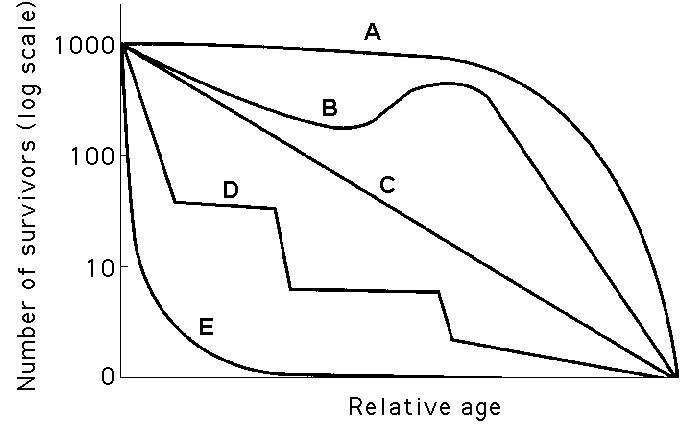 Which curve best describes survivorship in elephants? A) A | back 51 A) A |
front 52  Which curve best describes survivorship in a marine crustacean that molts? A) A | back 52 D) D |
front 53 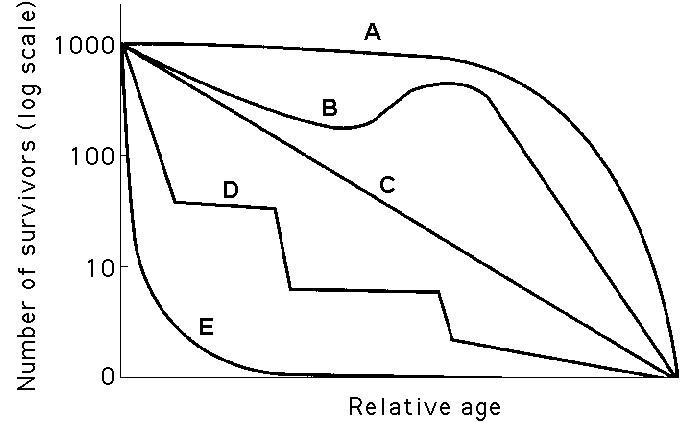 Which curve best describes survivorship in humans who live in undeveloped nations? A) A | back 53 A) A |
front 54 Which of the following statements about the evolution of life histories is correct? A) Stable environments with limited resources favor r-selected
populations. | back 54 C) Most populations have both r- and K-selected characteristics that vary under different environmental conditions. |
front 55 Which of the following is characteristic of K-selected populations? A) offspring with good chances of survival | back 55 A) offspring with good chances of survival |
front 56 Which pair of terms most accurately describes life history traits for a stable population of wolves? A) semelparous; r-selected | back 56 D) iteroparous; K-selected |
front 57 Carrying capacity is A) seldom reached by marine producers and consumers because of
the vast resources of the ocean. | back 57 B) the maximum population size that a particular environment can support. |
front 58 A population's carrying capacity A) may change as environmental conditions change. | back 58 A) may change as environmental conditions change. |
front 59 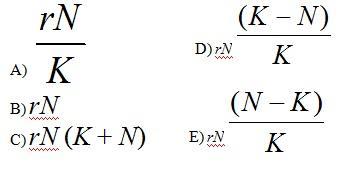 Exponential growth of a population is represented by dN/dt = | back 59 Answer: B |
front 60 Which of the following is the equation for zero population growth (ZPG)? A) R = b - m | back 60 A) R = b - m |
front 61  Logistic growth of a population is represented by dN/dt = | back 61 Answer: D |
front 62 Which of the following is an example of cryptic coloration? A) bands on a coral snake | back 62 E) a "walking stick" insect that resembles a twig |
front 63 Which of the following is an example of aposematic coloration? A) stripes of a skunk | back 63 A) stripes of a skunk |
front 64 Which of the following is an example of Müllerian mimicry? A) two species of unpalatable butterfly that have the same color
pattern | back 64 A) two species of unpalatable butterfly that have the same color pattern |
front 65 Evidence shows that some grasses benefit from being grazed. Which of the following terms would best describe this plant-herbivore interaction? A) mutualism | back 65 A) mutualism |
front 66 Dwarf mistletoes are flowering plants that grow on certain forest trees. They obtain nutrients and water from the vascular tissues of the trees. The trees derive no known benefits from the dwarf mistletoes. Which of the following best describes the interactions between dwarf mistletoes and trees? A) mutualism | back 66 B) parasitism |
front 67 Which of the following terms is used by ecologists to describe the community interaction where one organism makes the environment more suitable for another organism? A) parasitism | back 67 D) facilitation |
front 68 Which of the following would be most significant in understanding the structure of an ecological community? A) determining how many species are present overall | back 68 E) determining how many species are present overall, which particular species are present, the kinds of interactions that occur among organisms of different species, and the relative abundance of species |
front 69 To recycle nutrients, an ecosystem must have, at a minimum, A) producers. | back 69 B) producers and decomposers. |
front 70 Secondary consumers that can eat only primary consumers receive what percent of the energy fixed by primary producers in a typical field ecosystem? A) 0.1% | back 70 B) 1% |
front 71 If you applied a fungicide to a cornfield, what would you expect to happen to the rate of decomposition and net ecosystem production (NEP)? A) Both decomposition rate and NEP would decrease. | back 71 E) Decomposition rate would decrease and NEP would increase. |
front 72 Aquatic primary productivity is most limited by which of the following? A) light and nutrient availability | back 72 A) light and nutrient availability |
front 73 What is the primary limiting factor for aquatic productivity? A) pressure | back 73 B) lack of nutrients |
front 74 Which of the following is the most accepted hypothesis as to why invasive species take over communities into which they have been introduced? A) Invasive species are more aggressive than native species in
competing for the limited resources of the environment. | back 74 B) Invasive species are not held in check by the predators and agents of disease that have always been in place for the native species. |
front 75 Which data is most useful to measure primary productivity in a
terrestrial ecosystem? | back 75 D) annual precipitation |
front 76 This term refers to the reflecting and absorption of infrared radiation by atmospheric methane, carbon dioxide, and water. A) depletion of ozone layer | back 76 D) greenhouse effect |
front 77 During the course of the formation of a parasite/host relationship, a critical first step in this evolution would be A) changing the behavior of the host or intermediate host.
| back 77 C) deriving nourishment without killing the host. |
front 78  Which letter represents an organism that could be a carnivore? A) A | back 78 E) E |
front 79  Which letter represents an organism that could be a producer?
| back 79 B) B |
front 80 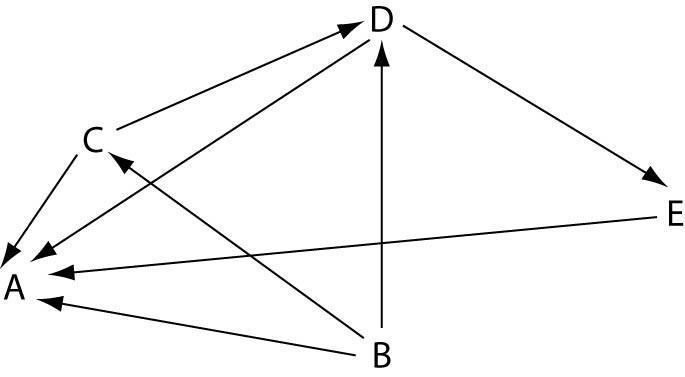 Which letter represents an organism that could be a primary consumer?
| back 80 C) C |
front 81 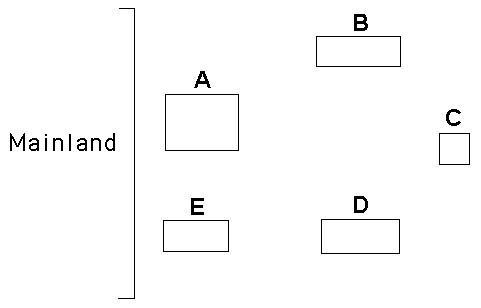 Which island would likely have the greatest species diversity?
| back 81 A) A |
front 82  Which island would likely exhibit the most impoverished species
diversity? | back 82 C) C |
front 83 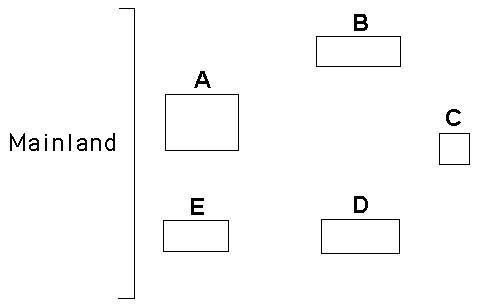 Which island would likely have the lowest extinction rate? | back 83 A) A |